Themed collection Selective catalytic reduction of NOx

Automotive NOx abatement using zeolite-based technologies
Guest Editors Raj Gounder and Ahmad Moini introduce this themed collection on the selective catalytic reduction of NOx.

React. Chem. Eng., 2019,4, 966-968
https://doi.org/10.1039/C9RE90030F
Perspective on SCR NOx control for diesel vehicles
The selective catalytic reduction of NOx with aqueous urea (“urea SCR”) is originally a steady-state technology that has been successfully applied to diesel vehicles worldwide. This Perspective summarizes 20+ years of SCR system research, design, and future improvements.
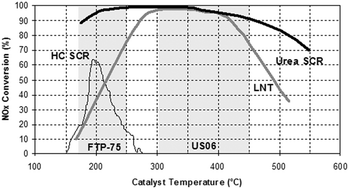
React. Chem. Eng., 2019,4, 969-974
https://doi.org/10.1039/C8RE00284C
Tracking mobile active sites and intermediates in NH3-SCR over zeolite catalysts by impedance-based in situ spectroscopy
Impedance-based in situ spectroscopy allows direct tracking of the mobile active sites and reaction intermediates in NH3-SCR over zeolite catalysts.
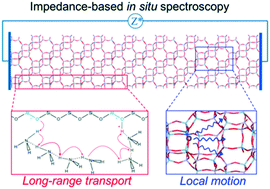
React. Chem. Eng., 2019,4, 986-994
https://doi.org/10.1039/C8RE00283E
Catalyst systems for selective catalytic reduction + NOx trapping: from fundamental understanding of the standard SCR reaction to practical applications for lean exhaust after-treatment
Physical mixtures of NOx adsorbers and SCR catalysts both for fundamental studies and for abatement of cold start NOx emissions.

React. Chem. Eng., 2019,4, 1165-1178
https://doi.org/10.1039/C9RE00012G
Recent advances in the preparation of zeolites for the selective catalytic reduction of NOx in diesel engines
Metal-exchanged zeolites with small pore sizes have attracted much attention in recent years due to their application in the selective catalytic reduction (SCR) of NOx in diesel engines.

React. Chem. Eng., 2019,4, 975-985
https://doi.org/10.1039/C8RE00214B
From metal-supported oxides to well-defined metal site zeolites: the next generation of passive NOx adsorbers for low-temperature control of emissions from diesel engines
Passive NOx adsorbers as new components to complement SCR catalysts to control cold-start NOx emissions efficiently.
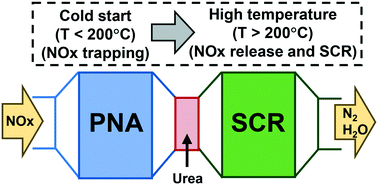
React. Chem. Eng., 2019,4, 223-234
https://doi.org/10.1039/C8RE00193F
Modeling and analysis of transport and reaction in washcoated monoliths: Cu-SSZ-13 SCR and dual-layer Cu-SSZ-13 + Pt/Al2O3 ASC
Modeling and analysis of washcoated single- and dual-layer monolith catalysts is presented for selective catalytic reduction (SCR) on Cu-SSZ-13 and ammonia oxidation on Cu-SSZ-13 + Pt/Al2O3 ammonia slip catalyst (ASC).
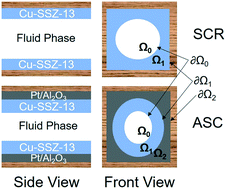
React. Chem. Eng., 2019,4, 1103-1115
https://doi.org/10.1039/C8RE00325D
Simulation of exotherms from the oxidation of accumulated carbonaceous species over a VSCR catalyst
A model is built to simulate the burn-off process of accumulated carbonaceous species over a VSCR catalyst.
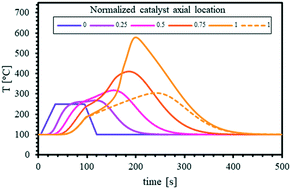
React. Chem. Eng., 2019,4, 1090-1102
https://doi.org/10.1039/C8RE00291F
Site selective adsorption and relocation of SOx in deactivation of Cu–CHA catalysts for NH3-SCR
SO2 selectively interacts with Z-CuOH in Cu–CHA catalysts for NH3-SCR and relocates to Z2-Cu during heating at 550 °C.
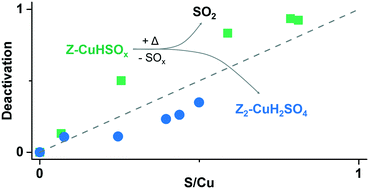
React. Chem. Eng., 2019,4, 1081-1089
https://doi.org/10.1039/C8RE00275D
Temperature-dependent dynamics of NH3-derived Cu species in the Cu-CHA SCR catalyst
In situ XAS and UV-vis–NIR spectroscopy shed light on Cu-speciation during NH3 temperature-programmed desorption and surface reaction (TPSR) over a commercial Cu-chabazite deNOx catalyst, expanding the fundamental knowledge required to unravel the NH3-SCR mechanism across the whole operation-relevant temperature range.
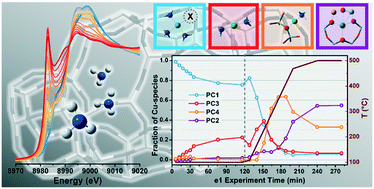
React. Chem. Eng., 2019,4, 1067-1080
https://doi.org/10.1039/C8RE00322J
Inter-particle migration of Cu ions in physically mixed Cu-SSZ-13 and H-SSZ-13 treated by hydrothermal aging
Physically mixed Cu-SSZ-13 and H-SSZ-13 catalysts were prepared using two different methods to control the extent of contact. Migration of Cu ions between particles is proved by discrepancy of two physical mixed catalysts.
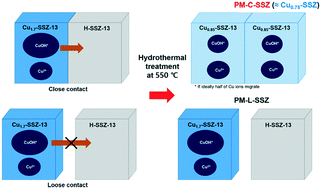
React. Chem. Eng., 2019,4, 1059-1066
https://doi.org/10.1039/C8RE00281A
Iron-exchanged high-silica LTA zeolites as hydrothermally stable NH3-SCR catalysts
Iron-exchanged high-silica LTA zeolites exhibit high activity for selective catalytic reduction of NOx by NH3, even after hydrothermal aging at 900 °C.
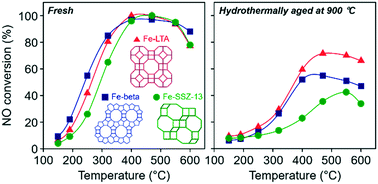
React. Chem. Eng., 2019,4, 1050-1058
https://doi.org/10.1039/C9RE00007K
The dynamic nature of Cu sites in Cu-SSZ-13 and the origin of the seagull NOx conversion profile during NH3-SCR
Systematic catalytic tests and in situ/operando spectroscopy uncovered structure–performance relationships determining the seagull profile of the NOx conversion for Cu-SSZ-13 catalysts.
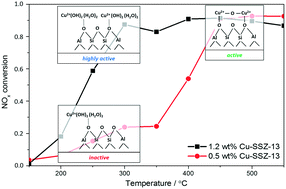
React. Chem. Eng., 2019,4, 1000-1018
https://doi.org/10.1039/C8RE00290H
Mechanism-based kinetic modeling of Cu-SSZ-13 sulfation and desulfation for NH3-SCR applications
A multi-site kinetic model was developed capable of predicting the sulfation and desulfation of Cu-SSZ-13 for the NH3 selective catalytic reduction (NH3-SCR) of NOx.
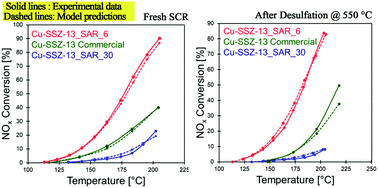
React. Chem. Eng., 2019,4, 1038-1049
https://doi.org/10.1039/C8RE00210J
About this collection
From RCE
Guest Editors: Professor Rajamani Gounder (Purdue University) and Dr Ahmad Moini (BASF)
The discovery of Cu-CHA was a significant breakthrough in automotive emissions catalysis, resulting in the selection of urea-SCR as the technology of choice for NOx removal from diesel exhaust. Since its commercial implementation one decade ago, research on the science and technology of urea-SCR on Cu-/Fe-CHA zeolites has proliferated rapidly, and is now a major topic of investigation in the catalysis and reaction engineering communities worldwide.
In this RCE themed collection, we showcase the global impact of this problem of major environmental significance, and the diverse chemistry and engineering approaches that are being used to study it.